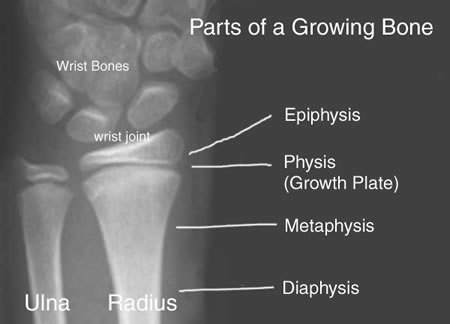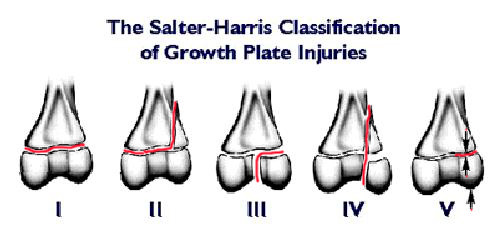Growth Plate Injuries (Physeal Fractures)
The Growth Plate
Our skeleton is a marvelous thing. It grows as we grow! And it does this without shutting down or closing for remodelling. A great thing, or we would be in real trouble!
The skeleton grows due to the presence of a region of the bone called (surprise!) the growth plate. The medical term for this is the physis (adjective form is physeal), and I mention it only so you can understand the term if you run into it and so that you can understand the names of the other parts of the bone.
Here are the parts of a growing bone. The example is of a wrist, partly because about 50% of growth plate injures are at the wrist and partly because that is the most likely growth plate injury my patients will have. In this xray, the wrist bones are at the top and the forearm bones at the bottom; the radius is the bone on the right, it is the one on the thumb side of the hand:

The epiphysis is the end of the bone, with the cartilage that makes up your joint ("epi" means "upon", so an epiphysis is the part of the bone that is on the physis). The physis is the growth plate, the part of the bone that has the cells that allows the bone to grow longer. The metaphysis is the broad region of bone right next to the physis. The diaphysis is the narrow center part of the bone.
The growth plate is made up of a special kind of cartilage called (surprise!) growth plate cartilage.
Growth Plate Injuries
Growth plate injuries occur in children, up until about age 16 for girls and 18 for boys. The growth plate is the weakest area of the growing bone, weaker than the metaphysis or the diaphysis, and weaker than the ligaments of the adjacent joint. In a growing child, a serious injury to a joint is more likely to damage a growth plate than the ligaments that stabilize the joint. Interestingly, each age bracket has a different response to a similar injury of falling on the outstretched arm: little children get fracture (break) to the bone that only bends it ("greenstick fracture"), older grammar school children get a growth plate injury, young adults will often get a fracture into the joint or a wrist dislocation, and an elderly person will fracture through the metaphysis. An injury that might cause a sprain in an adult may cause a growth plate injury in a child.
Growth Plate Injuries are Fractures
Growth plate injuries are actually a broken bone, which is the same thing as a fracture. They represent about 15 percent of all childhood fractures. They occur twice as often in boys as in girls, with the greatest incidence among 14- to 16-year-old boys and 11- to 13-year-old girls. Older girls experience these fractures less often because their growth plates stop growing and change into solid bone at an earlier age than boys. Boys have a higher rate of fractures due to their more aggressive form of play. In my practice, if you exclude the fractures in girls from falling off horses, boys outnumber the girls probably 4 to1! And all of my "high volume" patients (4 or more fractures) are all boys.
Signs That Require a Visit to the Doctor
- Inability to continue play because of pain following an acute or sudden injury
- Decreased ability to play over the long term because of persistent pain following a previous injury
- Visible deformity of the child’s arms or legs
- Severe pain from acute injuries that prevent the use of an arm or leg.
Adapted from Play It Safe, a Guide to Safety for Young Athletes, by the American Academy of Orthopaedic Surgeons.
Classification of Growth Plate Injuries (Fractures)
The fractures of the growth plate are classified according to the system of Drs. Salter and Harris. This diagram is from their text Disorders and Injuries of the Musculoskeletal System, 3rd Edition. Robert B. Salter, Baltimore, Williams and Wilkins, 1999, and is from the National Institutes of Health website, which has permission to use this image. I added the red color, to show where the fracture is in each case.

I mention this classification system because you will almost certainly hear about it. Unfortunately, it does not actually tell us much about how the fracture should be treated or what the outcome will be.
Complications of Growth Plate Injuries (Fractures)
The main concern about growth plate injuries is that the growing cells can be injured by the fall, which must have been rather forceful, or the growth plate would not have broken. (Most falls don't result in a fracture, do they?) They can also be injured by the doctor, when he or she is trying to help correct the problem by straightening out the broken bone, which is why we try to do it very, very gently. Almost all of growth plate injuries of the forearm heal without any problem (the main problem occurs in knee and hip growth plate injuries, which fact you should bear in mind when you are reading generalized statistics about growth plate injuries). The challenge is that we cannot see the growing cells on the xray (see the photo at the top, and note that the physis is the clear section between the physis and the metaphysis) and we cannot tell if they are injured enough to stop growing or not. Even CT scans and MRI's cannot tell if they are injured enough to stop growing. The only way to tell is to treat the fracture gently and watch how the bone grows by taking xrays over a period of about 12 months. The diagnosis is always made with the 20-20 of hindsight (what the doctors call a "retrospective diagnosis").
The incidence of growth plate closure (what happens if the growing cells are injured enough to stop growing) is very rare. I have not yet seen one in my practice, and a well-respected, published paper cites a rate of 1 case in 547 distal radius (forearm) fractures (Davis and Green, Forearm Fractures in Children, 1976; Dr. David Green is the author of the most respected hand surgery textbook. I have had him out as a guest speaker for the San Francisco Bay Area Hand Surgery Society.) The rate of growth plate closure varies with the amount of trauma that the forearm was subjected to, among other factors, many of which are still undefined.
The reason I am bringing this up, even though growth plate injuries are very rare, is that if the growth plate is injured enough and it closes, the bone does not grow properly. It can stop growing entirely, which may not be a problem in an older child. It can stop growing only on one side, which in children with a large amount of growth left can cause the bone to grow crooked. These problems are even more rare than growth plate injuries (that is, most growth plate injuries heal without any problems), and usually is not even noticed by the patient. In one long-term study of growth plate injures (157 fractures followed for an average of 25 years, a remarkable study, indeed), only 7 had shortening or angulation of the radius, and only 2 were noticed by the patients, and only 3 needed surgery (Cannata, et al. Physeal Fractures of the Distal Radius and Ulna: Long-Term Prognosis, 2003). The majority of the growth plate injuries resulting in bone growth problems had very special kinds of injuries, such a open fractures (bone sticking out of the skin or similar "compound" fractures) that got infected, injuries in which the growth plate of both the radius and the ulna were present, or other rather unusual kinds of injuries. Growth plate injuries and growth disturbances are very rare in the typical, simple fall on an outstretched arm. I recommend follow-up xrays just to be sure there is NO growth plate and bone abnormalities present, not because I expect them to be present.
How Are Growth Plate Injuries (Fractures) Treated?
In general, we like to straighten out (reduce) fractures, which includes growth plate injuries. We straighten them out (reduce them) as gently as possible, and try not to do repeat reductions. The mild deformity left after a growth plate fracture almost always remodels and growth plate injuries resulting in closure are rare. If your child has sustained a growth plate injury, we will discuss it when you are in the office and will take xrays over time (sometimes over a period
Further Reading
The essay at eMedicine is for doctors, but goes into this at much greater length: Growth Plate Fractures
The National Institutes of Arthritis and Musculoskeletal and Skin Diseases has a page on Growth Plate Injuries.
